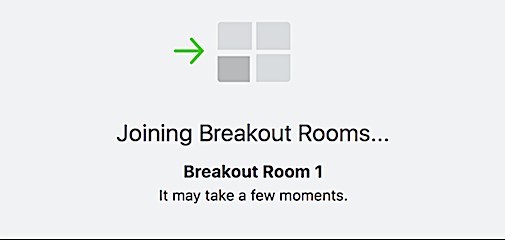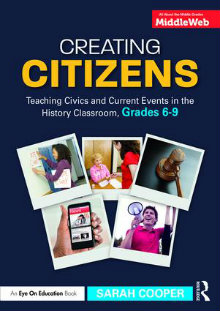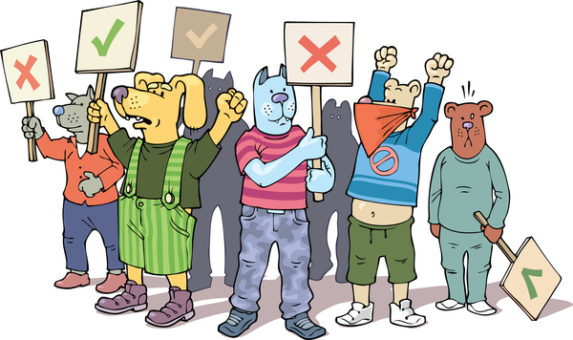The Ups and Downs of Zoom Breakout Rooms
A MiddleWeb Blog
 Sending my students into Zoom breakout rooms last spring to work on projects or discuss their opinions seemed easy – an extension of sitting in class and talking in pairs or small groups.
Sending my students into Zoom breakout rooms last spring to work on projects or discuss their opinions seemed easy – an extension of sitting in class and talking in pairs or small groups.
When the pandemic struck, I already knew every student well from our in-class time together and had an idea of how everyone would behave, even the perspectives they might take. Higher risk conversations felt manageable.
After two weeks of online teaching with new students this fall, though, I’m rethinking how I use this appealing online tool. I can’t walk around the room and have my antennae up everywhere all at once.
As a result, I feel more comfortable asking students to engage in low-risk discussions or do low-level tasks in breakout rooms – and much less comfortable than I would have imagined asking them to share opinions on sensitive topics in a space I can’t see.
What Is Working
1. Playing with material in no-stakes or low-stakes ways.
Often I’ll begin the year by asking students to learn key vocabulary that can help unlock current events headlines, such as pension or sanctions. This year we played a daily “gravity” game together as a class on Quizlet with several sets of words. There was nothing high-tech about this. After asking everyone to unmute, I shared my screen and they shouted out the answers as the asteroids dropped. It’s the closest I’ve come online to the welcome cacophony of a middle school classroom.
After we had finished three days of quizzes, with 18 words total, students went into breakout groups of four or five for ten minutes. With their group, they had to write a (very) short story using as many words correctly as they could.
This breakout activity had a time limit, no stakes except completion, and the potential for humor (which I said needed to be appropriate and non-offensive). When they finished, one member from each group posted their writing in the chat so that everyone could enjoy it. Here are two examples, with vocabulary words italicized:
✻ After the midterm election, totalitarianism was established as the government, but a coup d’etat followed. This led the United Nations to impose sanctions that led to the collapse of the Federal Reserve. However, some grassroots groups lobbied for equitable treatment from the government, because not one had any more pensions.
✻ There’s a cat running for president and a lobbyist is convincing people to vote for the cat. The cat wins and it is totalitarian and there is a coup d’etat. The cat gets overthrown by the dogs. Dogs cause a surge and now the dogs are equitable.
2. Checking homework in breakout groups while students work on an individual assignment.
Recently students went into breakout groups of four or five to work for twenty minutes on a paragraph due later that week: a summary of an interview they did with an adult about how they follow the news. They didn’t have to talk with each other, but they could keep each other company while they worked.
Then I popped into the breakout groups to check notes students had done for homework, either by their holding up handwritten notes to the camera or by sharing their screen with me.
This relaxed time gave the students a chance to get work done without feeling like they were alone. It also let me connect with them individually while not having to “collect” another homework assignment online.
What Is Not Working as Well
1. Asking students to “pair and share.”
In an opening faculty meeting in August, we spent time in two-person breakout groups to catch up on the summer. For teachers who were generally familiar with each other already, this was a welcome chance to reconnect or get to know someone better.
At that meeting, however, a few teachers pointed out that, for students, it could feel uncomfortable to be one-on-one with someone they didn’t know that well or didn’t have a good relationship with.
I’ve kept this caveat in mind when assigning breakout groups in class, usually leaning toward three people or more. The one time I assigned a two-minute, two-person group to reflect on a current events article, it felt strange to me, because as a teacher I couldn’t sense the classroom dynamic.
2. Having a breakout group without a product at the end.
Even for a five-minute breakout group, I’ve found that students will work better together if they have to report back something to the class when they’re done. Of course, this is true in person, too! Online it could take the form of:
✻ Asking students to be ready to share their idea or someone else’s idea. When we’re back together, I will cold call a few people to hear their thoughts.
✻ Suggesting that everyone post an idea in the chat that they liked from a partner. Again, I follow up by calling on a few people to explain in more depth.
It’s also possible to stop in with each breakout group and ask for an update on the discussion, but I’ve found that this usually takes too long. Such check-ins work better for long-term projects when students are together over multiple days and for longer periods of time, such as this resilient history podcast project from last spring.
3. Talking about anything controversial in breakout groups.
This is probably the most surprising realization I’ve had since starting the new school year. It might be unique to middle schoolers, but I’ve found that – without my being able to physically walk around and encourage some groups to process and think together – students can be reluctant to share their ideas online about historical or current controversies.
Recently, my partner eighth-grade English teacher and I discovered that we had both decided to wade into difficult conversations a little more slowly online than we might otherwise. This approach applies to full-class settings and certainly to breakouts.
Without the physical classroom, where I can read body language and feel people lean into or away from each other, it is harder to make our Zoom room a place where I feel that everyone is safe to express their opinions. It’s possible, but I think it’s going to take a lot longer than usual. I’ll keep you posted. And please share what you’re discovering!








































Pros and Cons can also be linked to what is being taught (course or subject)
I’m an EFL teacher and fluency is crucial when it comes to learning a language. For this reason the breakout rooms play an essential part of my classes. If students do not seem to have enough confidence or they lack of vocabulary to share their answers here’s what I did:
By providing floor holders or gap-fill phrases based on skill, activity or product students can stay afloat when COMMUNICATING in pairs using the breakout rooms. So I had to create a lot of guided dialogues or scripts for each stage of the class and it has worked perfectly; especially basic levels. Obviously, teachers haveto provide a clear example or enough scaffolded transitions BEFORE going into the breakout room.
Also, by mastering the platform at ease the teachers can make smoother transitions by going in and out the rooms. I’ve tested this since March and I had teachers take mini trainings on breakout rooms so they could be able to use it with a suitable pace. In additon, another reason breakout rooms MUST work is because most students are adults so they really want to put language into practice.
As far as children or teens, well I suppose it takes quite longer to get them interact in pairs independently because of the lack of resources that a classroom offers. However, this slow transition could be based on adaptation. We are just starting so perhaps in 5 or 10 years from now these types of struggles or learning obstacles won’t happen any more due to a higher level of autonomy or flexibility to change…who knows!